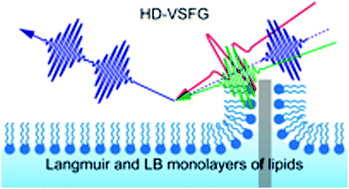Molecular conformation of DPPC phospholipid Langmuir and Langmuir–Blodgett monolayers studied by heterodyne-detected vibrational sum frequency generation spectroscopy†
Abstract
Heterodyne-detected (phase-sensitive) vibrational sum frequency generation spectroscopy was used to investigate molecular structures of 1,2-dipalmitoyl-sn-glycero-3-phosphocholine (DPPC) monolayers on water (Langmuir monolayer) and monolayers on a fused silica substrate (Langmuir–Blodgett [LB] monolayer). The spectral features in the CH stretching region depended on the phase of the Langmuir monolayer, which was controlled by the molecular area on water. From the spectral changes, the molecular structure of the monolayer in each phase was deduced at the molecular level. We discovered that when we compared Langmuir and LB monolayers, both of which correspond to a similar surface pressure, the LB monolayer tended to have fewer gauche defects and have less tilted terminal methyls in the n-pentadecyl groups than the corresponding Langmuir monolayer. In addition, weak vibrational bands, which have been hardly seen by the conventional (homodyne-detected) VSFG spectroscopy, were clearly observed with their phases, or arguments, for the first time.



 Please wait while we load your content...
Please wait while we load your content...